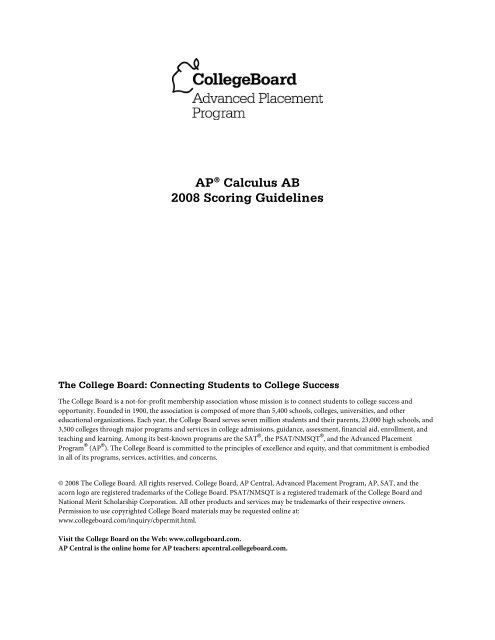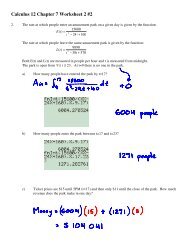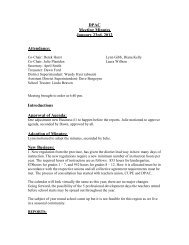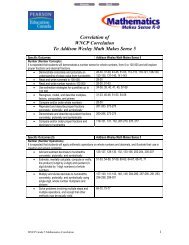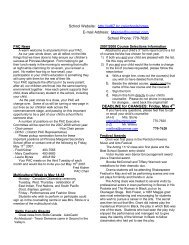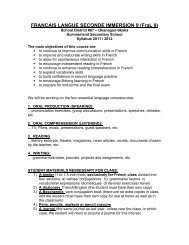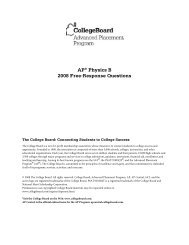AP® Calculus AB 2008 Scoring Guidelines - AP Central - College ...
AP® Calculus AB 2008 Scoring Guidelines - AP Central - College ...
AP® Calculus AB 2008 Scoring Guidelines - AP Central - College ...
You also want an ePaper? Increase the reach of your titles
YUMPU automatically turns print PDFs into web optimized ePapers that Google loves.
<strong>AP</strong> ® <strong>Calculus</strong> <strong>AB</strong><br />
<strong>2008</strong> <strong>Scoring</strong> <strong>Guidelines</strong><br />
The <strong>College</strong> Board: Connecting Students to <strong>College</strong> Success<br />
The <strong>College</strong> Board is a not-for-profit membership association whose mission is to connect students to college success and<br />
opportunity. Founded in 1900, the association is composed of more than 5,400 schools, colleges, universities, and other<br />
educational organizations. Each year, the <strong>College</strong> Board serves seven million students and their parents, 23,000 high schools, and<br />
3,500 colleges through major programs and services in college admissions, guidance, assessment, financial aid, enrollment, and<br />
teaching and learning. Among its best-known programs are the SAT ® , the PSAT/NMSQT ® , and the Advanced Placement<br />
Program ® (<strong>AP</strong> ® ). The <strong>College</strong> Board is committed to the principles of excellence and equity, and that commitment is embodied<br />
in all of its programs, services, activities, and concerns.<br />
© <strong>2008</strong> The <strong>College</strong> Board. All rights reserved. <strong>College</strong> Board, <strong>AP</strong> <strong>Central</strong>, Advanced Placement Program, <strong>AP</strong>, SAT, and the<br />
acorn logo are registered trademarks of the <strong>College</strong> Board. PSAT/NMSQT is a registered trademark of the <strong>College</strong> Board and<br />
National Merit Scholarship Corporation. All other products and services may be trademarks of their respective owners.<br />
Permission to use copyrighted <strong>College</strong> Board materials may be requested online at:<br />
www.collegeboard.com/inquiry/cbpermit.html.<br />
Visit the <strong>College</strong> Board on the Web: www.collegeboard.com.<br />
<strong>AP</strong> <strong>Central</strong> is the online home for <strong>AP</strong> teachers: apcentral.collegeboard.com.
<strong>AP</strong> ® CALCULUS <strong>AB</strong><br />
<strong>2008</strong> SCORING GUIDELINES<br />
Question 1<br />
3<br />
Let R be the region bounded by the graphs of y = sin( π x)<br />
and y = x − 4 x,<br />
as shown in the figure<br />
above.<br />
(a) Find the area of R.<br />
(b) The horizontal line y =− 2 splits the region R into two parts. Write, but do not evaluate, an integral<br />
expression for the area of the part of R that is below this horizontal line.<br />
(c) The region R is the base of a solid. For this solid, each cross section perpendicular to the x-axis is a<br />
square. Find the volume of this solid.<br />
(d) The region R models the surface of a small pond. At all points in R at a distance x from the y-axis,<br />
the depth of the water is given by hx ( ) = 3 − x.<br />
Find the volume of water in the pond.<br />
3<br />
(a) sin ( π x)<br />
= x − 4x<br />
at x = 0 and x = 2<br />
2<br />
3<br />
Area ∫ ( ( ) ( ))<br />
= sin π x − x − 4x dx = 4<br />
0<br />
3 :<br />
⎧<br />
⎪<br />
⎨<br />
⎪<br />
⎩<br />
1 : limits<br />
1 : integrand<br />
1 : answer<br />
(b)<br />
x<br />
3<br />
− 4x<br />
= − 2 at r = 0.5391889 and s = 1.6751309<br />
s<br />
3<br />
The area of the stated region is<br />
∫ ( − 2 − ( − 4 ))<br />
r<br />
x x dx<br />
2 : { 1 : limits<br />
1 : integrand<br />
(c) Volume = 2<br />
3 2<br />
∫ ( sin ( π x ) − ( x − 4 x ))<br />
dx = 9.978<br />
2 : { 1 : integrand<br />
0<br />
1 : answer<br />
(d) Volume = 2<br />
3<br />
∫ ( 3 − x )( sin ( π x ) − ( x − 4 x ))<br />
dx = 8.369 or 8.370 2 : { 1 : integrand<br />
0<br />
1 : answer<br />
© <strong>2008</strong> The <strong>College</strong> Board. All rights reserved.<br />
Visit the <strong>College</strong> Board on the Web: www.collegeboard.com.
<strong>AP</strong> ® CALCULUS <strong>AB</strong><br />
<strong>2008</strong> SCORING GUIDELINES<br />
Question 2<br />
t (hours) 0 1 3 4 7 8 9<br />
Lt ()(people) 120 156 176 126 150 80 0<br />
Concert tickets went on sale at noon ( t = 0)<br />
and were sold out within 9 hours. The number of people waiting in<br />
line to purchase tickets at time t is modeled by a twice-differentiable function L for 0 ≤ t ≤ 9. Values of Lt () at<br />
various times t are shown in the table above.<br />
(a) Use the data in the table to estimate the rate at which the number of people waiting in line was changing at<br />
5:30 P.M. ( t = 5.5 ).<br />
Show the computations that lead to your answer. Indicate units of measure.<br />
(b) Use a trapezoidal sum with three subintervals to estimate the average number of people waiting in line during<br />
the first 4 hours that tickets were on sale.<br />
(c) For 0 ≤ t ≤ 9, what is the fewest number of times at which L′ () t must equal 0 ? Give a reason for your answer.<br />
2<br />
(d) The rate at which tickets were sold for 0 ≤ t ≤ 9 is modeled by rt () = 550te −t tickets per hour. Based on the<br />
model, how many tickets were sold by 3 P.M. ( t = 3, ) to the nearest whole number?<br />
L( 7) − L( 4)<br />
150 126<br />
(a) L′ −<br />
( 5.5)<br />
≈ = = 8 people per hour<br />
7 − 4 3<br />
(b) The average number of people waiting in line during the first 4 hours is<br />
approximately<br />
1 ⎛ L( 0 ) + L( 1 ) L() ( ) ( ) ( ) ( 1 0 ) 1 + L 3 L<br />
(3 1) 3 + L 4 ( 4 3 )<br />
⎞<br />
4<br />
⎜<br />
− + − + −<br />
2 2 2<br />
⎟<br />
⎝<br />
⎠<br />
= 155.25 people<br />
(c) L is differentiable on [ 0, 9 ] so the Mean Value Theorem implies<br />
L′ () t > 0 for some t in ( 1, 3 ) and some t in ( 4, 7 ). Similarly,<br />
L′ () t < 0 for some t in ( 3, 4 ) and some t in ( 7, 8 ). Then, since L′ is<br />
continuous on [ 0, 9 ], the Intermediate Value Theorem implies that<br />
L′ () t = 0 for at least three values of t in [ 0, 9 ].<br />
OR<br />
The continuity of L on [ 1, 4 ] implies that L attains a maximum value<br />
there. Since L( 3) > L( 1)<br />
and L( 3) > L( 4 ),<br />
this maximum occurs on<br />
( 1, 4 ). Similarly, L attains a minimum on ( 3, 7 ) and a maximum on<br />
( 4, 8 ). L is differentiable, so L′ () t = 0 at each relative extreme point<br />
on ( 0, 9 ). Therefore L′ () t = 0 for at least three values of t in [ 0, 9 ].<br />
[Note: There is a function L that satisfies the given conditions with<br />
L′ () t = 0 for exactly three values of t.]<br />
∫<br />
3<br />
0<br />
(d) rt () dt= 972.784<br />
There were approximately 973 tickets sold by 3 P.M.<br />
2 : { 1 : estimate<br />
1 : units<br />
1 : trapezoidal sum<br />
2 : { 1 : answer<br />
3 :<br />
3 :<br />
⎧ 1 : considers change in<br />
⎪ sign of L′<br />
⎨<br />
⎪<br />
1 : analysis<br />
⎪⎩ 1 : conclusion<br />
OR<br />
⎧ 1 : considers relative extrema<br />
⎪ of L on ( 0, 9)<br />
⎨<br />
⎪ 1 : analysis<br />
⎪⎩ 1 : conclusion<br />
2 : { 1 : integrand<br />
1 : limits and answer<br />
© <strong>2008</strong> The <strong>College</strong> Board. All rights reserved.<br />
Visit the <strong>College</strong> Board on the Web: www.collegeboard.com.
<strong>AP</strong> ® CALCULUS <strong>AB</strong><br />
<strong>2008</strong> SCORING GUIDELINES<br />
Question 3<br />
Oil is leaking from a pipeline on the surface of a lake and forms an oil slick whose volume increases at a<br />
constant rate of 2000 cubic centimeters per minute. The oil slick takes the form of a right circular cylinder<br />
with both its radius and height changing with time. (Note: The volume V of a right circular cylinder with<br />
radius r and height h is given by V = π r 2 h.<br />
)<br />
(a) At the instant when the radius of the oil slick is 100 centimeters and the height is 0.5 centimeter, the<br />
radius is increasing at the rate of 2.5 centimeters per minute. At this instant, what is the rate of change<br />
of the height of the oil slick with respect to time, in centimeters per minute?<br />
(b) A recovery device arrives on the scene and begins removing oil. The rate at which oil is removed is<br />
R() t = 400 t cubic centimeters per minute, where t is the time in minutes since the device began<br />
working. Oil continues to leak at the rate of 2000 cubic centimeters per minute. Find the time t when<br />
the oil slick reaches its maximum volume. Justify your answer.<br />
(c) By the time the recovery device began removing oil, 60,000 cubic centimeters of oil had already<br />
leaked. Write, but do not evaluate, an expression involving an integral that gives the volume of oil at<br />
the time found in part (b).<br />
(a) When r = 100 cm and h = 0.5 cm,<br />
and<br />
dr<br />
dt<br />
= 2.5 cm min.<br />
dV dr 2 dh<br />
= 2πr h + πr<br />
dt dt dt<br />
2000 = 2π( 100)( 2.5)( 0.5) + π( 100) 2<br />
dh<br />
dt<br />
= 0.038 or 0.039 cm min<br />
dV<br />
dt<br />
dh<br />
dt<br />
=<br />
3<br />
2000 cm min<br />
⎧ dV<br />
dr<br />
1 : = 2000 and = 2.5<br />
dt<br />
dt<br />
⎪<br />
4 : ⎨<br />
dV<br />
2 : expression for<br />
⎪<br />
dt<br />
⎪<br />
⎩ 1 : answer<br />
dV<br />
dV<br />
(b) = 2000 − R()<br />
t , so = 0 when Rt () = 2000.<br />
dt<br />
dt<br />
This occurs when t = 25 minutes.<br />
dV<br />
dV<br />
Since > 0 for 0 < t < 25 and < 0 for t > 25,<br />
dt<br />
dt<br />
the oil slick reaches its maximum volume 25 minutes after the<br />
device begins working.<br />
3 :<br />
⎧ 1 : Rt () = 2000<br />
⎪<br />
⎨ 1 : answer<br />
⎪<br />
⎩ 1 : justification<br />
3<br />
(c) The volume of oil, in cm , in the slick at time t = 25 minutes<br />
25<br />
is given by 60,000 + ( 2000 − R()<br />
t ) dt.<br />
∫<br />
0<br />
1 : limits and initial condition<br />
2 : { 1 : integrand<br />
© <strong>2008</strong> The <strong>College</strong> Board. All rights reserved.<br />
Visit the <strong>College</strong> Board on the Web: www.collegeboard.com.
<strong>AP</strong> ® CALCULUS <strong>AB</strong><br />
<strong>2008</strong> SCORING GUIDELINES<br />
Question 4<br />
A particle moves along the x-axis so that its velocity at time t, for 0 ≤ t ≤ 6, is given by a differentiable<br />
function v whose graph is shown above. The velocity is 0 at t = 0, t = 3, and t = 5, and the graph has<br />
horizontal tangents at t = 1 and t = 4. The areas of the regions bounded by the t-axis and the graph of v on<br />
5, 6 are 8, 3, and 2, respectively. At time t = 0, the particle is at x =− 2.<br />
the intervals [ 0, 3 ], [ 3, 5 ], and [ ]<br />
(a) For 0 ≤ t ≤ 6, find both the time and the position of the particle when the particle is farthest to the left.<br />
Justify your answer.<br />
(b) For how many values of t, where 0 ≤ t ≤ 6, is the particle at x =− 8 ? Explain your reasoning.<br />
(c) On the interval 2 < t < 3, is the speed of the particle increasing or decreasing? Give a reason for your<br />
answer.<br />
(d) During what time intervals, if any, is the acceleration of the particle negative? Justify your answer.<br />
(a) Since vt () < 0 for 0 < t < 3 and 5 < t < 6, and vt () > 0<br />
for 3 < t < 5, we consider t = 3 and t = 6.<br />
3<br />
x( 3) =− 2 + v( t)<br />
dt =−2 − 8 =−10<br />
∫<br />
∫<br />
0<br />
6<br />
0<br />
x( 6) =− 2 + v( t)<br />
dt =−2 − 8 + 3− 2 =−9<br />
Therefore, the particle is farthest left at time t = 3 when<br />
its position is x ( 3)<br />
=− 10.<br />
(b) The particle moves continuously and monotonically from<br />
x ( 0)<br />
=− 2 to x ( 3)<br />
=− 10. Similarly, the particle moves<br />
continuously and monotonically from x ( 3)<br />
=− 10 to<br />
x ( 5)<br />
=− 7 and also from x ( 5)<br />
=− 7 to x ( 6)<br />
=− 9.<br />
By the Intermediate Value Theorem, there are three values<br />
of t for which the particle is at xt () =− 8.<br />
(c) The speed is decreasing on the interval 2 < t < 3 since on<br />
this interval v < 0 and v is increasing.<br />
(d) The acceleration is negative on the intervals 0 < t < 1 and<br />
4 < t < 6 since velocity is decreasing on these intervals.<br />
⎧ 1 : identifies t = 3 as a candidate<br />
⎪<br />
6<br />
3 : ⎨ 1 : considers<br />
∫<br />
vt () dt<br />
0<br />
⎪<br />
⎪⎩ 1 : conclusion<br />
3 :<br />
⎧ 1 : positions at t = 3, t = 5,<br />
⎪ and t = 6<br />
⎨<br />
⎪<br />
1 : description of motion<br />
⎪⎩ 1 : conclusion<br />
1 : answer with reason<br />
2 : { 1 : answer<br />
1 : justification<br />
© <strong>2008</strong> The <strong>College</strong> Board. All rights reserved.<br />
Visit the <strong>College</strong> Board on the Web: www.collegeboard.com.
<strong>AP</strong> ® CALCULUS <strong>AB</strong><br />
<strong>2008</strong> SCORING GUIDELINES<br />
Question 5<br />
dy y − 1<br />
Consider the differential equation =<br />
2 , where x ≠ 0.<br />
dx x<br />
(a) On the axes provided, sketch a slope field for the given differential<br />
equation at the nine points indicated.<br />
(Note: Use the axes provided in the exam booklet.)<br />
(b) Find the particular solution y = f( x)<br />
to the differential equation with<br />
the initial condition f ( 2)<br />
= 0.<br />
(c)<br />
For the particular solution y = f( x)<br />
described in part (b), find<br />
lim f ( x)<br />
.<br />
x→∞<br />
(a)<br />
1 : zero slopes<br />
2 : { 1 : all other slopes<br />
(b)<br />
1 1<br />
dy = dx<br />
y − 1 2<br />
x<br />
1<br />
ln y − 1 = − + C<br />
x<br />
y − 1 = e<br />
1<br />
−<br />
2<br />
1<br />
2<br />
1<br />
− + C<br />
x<br />
y − 1 = e e<br />
1<br />
−<br />
x<br />
y − 1 = ke , where k = ± e<br />
− 1 = ke<br />
k<br />
=−e<br />
1<br />
C<br />
−<br />
x<br />
1 1<br />
( )<br />
( ) 2 −<br />
x<br />
f x = 1 − e , x > 0<br />
C<br />
6 :<br />
⎧ 1 : separates variables<br />
⎪ 2 : antidifferentiates<br />
⎪<br />
⎨ 1 : includes constant of integration<br />
⎪ 1 : uses initial condition<br />
⎪<br />
⎩ 1 : solves for y<br />
Note: max 3 6 [1-2-0-0-0] if no constant<br />
of integration<br />
Note: 0 6 if no separation of variables<br />
1 1<br />
( )<br />
(c) 2 −<br />
x<br />
lim 1 e 1 e<br />
→∞ − = − 1 : limit<br />
x<br />
© <strong>2008</strong> The <strong>College</strong> Board. All rights reserved.<br />
Visit the <strong>College</strong> Board on the Web: www.collegeboard.com.
<strong>AP</strong> ® CALCULUS <strong>AB</strong><br />
<strong>2008</strong> SCORING GUIDELINES<br />
Question 6<br />
ln x<br />
Let f be the function given by f( x)<br />
= for all x > 0. The derivative of f is given by<br />
x<br />
1−<br />
ln x<br />
f′ ( x) =<br />
2 .<br />
x<br />
(a) Write an equation for the line tangent to the graph of f at x = e 2 .<br />
(b) Find the x-coordinate of the critical point of f. Determine whether this point is a relative minimum, a<br />
relative maximum, or neither for the function f. Justify your answer.<br />
(c) The graph of the function f has exactly one point of inflection. Find the x-coordinate of this point.<br />
(d) Find lim f ( x)<br />
.<br />
+<br />
x→0<br />
2<br />
2 ln 2<br />
(a) f( e )<br />
e<br />
2 2 ,<br />
2 1−<br />
lne<br />
1<br />
= = f′ ( e ) = = −<br />
2 4<br />
e e<br />
2<br />
( e )<br />
e<br />
2 1 2<br />
An equation for the tangent line is y = − ( x − e )<br />
2<br />
e<br />
2 4<br />
e<br />
.<br />
⎪⎧ ( 2 ) ( 2<br />
)<br />
2 : 1 : f e and f′<br />
e<br />
⎨<br />
⎪⎩ 1 : answer<br />
(b) f′ ( x) = 0 when x = e.<br />
The function f has a relative maximum<br />
at x = e because f ′( x)<br />
changes from positive to negative at<br />
x = e.<br />
3 :<br />
⎧<br />
⎪<br />
⎨<br />
⎪<br />
⎩<br />
1 : x = e<br />
1 : relative maximum<br />
1 : justification<br />
1 2<br />
− x − ( 1−<br />
ln x)<br />
2x<br />
3 2ln x<br />
(c) f ( x)<br />
x<br />
− +<br />
′′ = = for all x > 0<br />
4 3<br />
x<br />
x<br />
f′′ ( x) = 0 when − 3 + 2ln x = 0<br />
⎧ 2 : f ′′( x)<br />
3 : ⎨<br />
⎩ 1 : answer<br />
x<br />
= e<br />
3 2<br />
The graph of f has a point of inflection at<br />
f ′′( x)<br />
changes sign at x = e 3 2 .<br />
x<br />
3 2<br />
= e because<br />
(d)<br />
ln x<br />
lim<br />
x<br />
+<br />
x→0<br />
=−∞ or Does Not Exist<br />
1 : answer<br />
© <strong>2008</strong> The <strong>College</strong> Board. All rights reserved.<br />
Visit the <strong>College</strong> Board on the Web: www.collegeboard.com.


